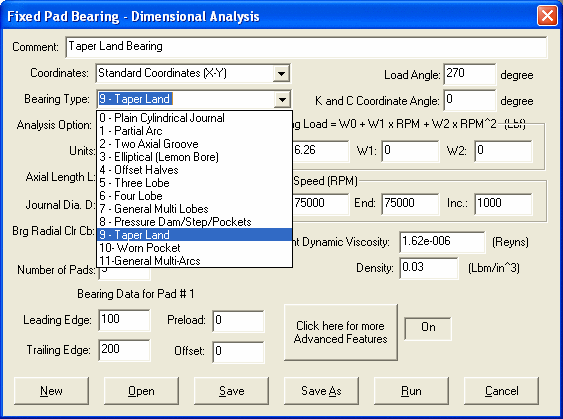
The fixed lobe bearing is made up of a number of fixed circular arc segments called lobes or pads. The lobes are separated by axial lubricant supply grooves. A three-lobe bearing is sketched to illustrate the parameters used to describe the bearing geometry. Clearances are exaggerated in the figure for illustrative purposes.

Two coordinate systems can be used in DyRoBeSİ_BePerf and they are described in the Coordinate Systems Section.
The journal static equilibrium position is defined by the journal eccentricity (e) and attitude angle ( ). Under dynamic conditions, the journal is oscillating with small amplitudes around this equilibrium position. However, the bearing dynamic coefficients (stiffness and damping coefficients) can be calculated in any coordinate system (x,y,z) by specifying a Coefficient Coordinate Angle in the bearing input data. The Coordinate Angle is measured from the X-axis (used to describe the bearing geometry and the load vector) to x-axis (used to describe the bearing coefficients). See Coefficients Coordinate Angle.
). Under dynamic conditions, the journal is oscillating with small amplitudes around this equilibrium position. However, the bearing dynamic coefficients (stiffness and damping coefficients) can be calculated in any coordinate system (x,y,z) by specifying a Coefficient Coordinate Angle in the bearing input data. The Coordinate Angle is measured from the X-axis (used to describe the bearing geometry and the load vector) to x-axis (used to describe the bearing coefficients). See Coefficients Coordinate Angle.
The bearing radius at minimum clearance (Rb) for a centered shaft can be described as the radius of the largest shaft that could be inserted into the bearing. A circle drawn based on Rb is referred to as a bearing base circle.
For a positive preloaded bearing, pad radius (Rp) is greater than bearing radius (Rb) and the circular pads are moved inward the bearing center. Thus, when the journal is centered in the bearing, the pads are loaded by geometry effect. The fraction of the distance between pad center of curvature and bearing center to pad radial clearance is called Preload:

when the preload is zero, the pad centers of curvature coincide with the bearing center and the bearing is cylindrical. When the preload has a value of 1, the shaft touches all the pads and the bearing minimum radial clearance is zero. Typical preload value for a fixed lobe bearing ranges from 0.4 to 0.75.
Another key parameter used to describe the preloaded bearing geometry is the fraction of converging pad length to the full arc length. This parameter is called Offset or Tilt and is given by the following expression:

The value of offset is meaningful only when the bearing is preloaded. At  p, the bearing has a minimum clearance for a centered shaft and the lobe arc intersects with bearing base circle.
p, the bearing has a minimum clearance for a centered shaft and the lobe arc intersects with bearing base circle.
A lobe which is symmetrically located with respect to the centered journal, i.e. offset = 0.5, is defined as having no lobe tilt and the clearance space has equal convergent and divergent arcs. An offset of 0.5 is commonly used to accommodate the reversal rotation of the shaft and also to avoid the problem of the bearing being installed backwards. An offset less than 0.5 increases the diverging film thickness and is not desirable. Typical offset ranges from 0.5 to 1.0. For an offset halves bearing, the offset could be larger than 1, depending on the position of pad center of curvature.
Several commonly used bearings are shown in the figures with clearance exaggerated for clarity. The capability of the program is not limited to these bearings.
Typical Bearing Types
Plain Cylindrical Journal Bearing
Elliptical (Lemon Bore) Bearing
See also Coordinate Systems, Nomenclature, Fixed Lobe Dimensional Analysis, Fixed Lobe Non-Dimensional Analysis, Examples.

Copyright © 2014-2017